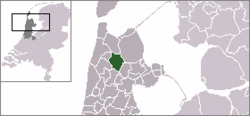Niedorp facts for kids
Quick facts for kids
Niedorp
|
|||
|---|---|---|---|
|
Former municipality
|
|||
|
|||
 |
|||
| Country | Netherlands | ||
| Province | North Holland | ||
| Municipality | Hollands Kroon | ||
| Area
(2006)
|
|||
| • Total | 62.99 km2 (24.32 sq mi) | ||
| • Land | 61.58 km2 (23.78 sq mi) | ||
| • Water | 1.41 km2 (0.54 sq mi) | ||
| Population
(1 January 2007)
|
|||
| • Total | 11,987 | ||
| • Density | 195/km2 (510/sq mi) | ||
| Source: CBS, Statline. | |||
| Time zone | UTC+1 (CET) | ||
| • Summer (DST) | UTC+2 (CEST) | ||
| Website | www.niedorp.nl | ||
Niedorp was once a small local government area, called a municipality, in the north-western Netherlands. It was located in the province of North Holland, within a region known as West-Frisia.
Long ago, in 1415, Niedorp and its nearby area, Barsingerhorn, were given special "city rights." This meant they had certain freedoms and privileges, like holding markets. Since 2012, Niedorp is no longer a separate municipality. Instead, it has become part of a larger municipality called Hollands Kroon.
Contents
Villages of Niedorp
The former municipality of Niedorp included several small towns and villages. These communities were part of Niedorp before it joined Hollands Kroon.
- Barsingerhorn
- Haringhuizen
- Kolhorn
- Lutjewinkel
- Nieuwe Niedorp
- Oude Niedorp
- 't Veld
- Winkel
- Zijdewind
Ancient Discoveries
Uncovering the Past
Archaeologists are like detectives who study old things to learn about the past. They found signs of very old settlements in areas of Niedorp called De Gouw and the Groetpolder. These settlements date back to a time known as the Late Neolithic period.
Life in the Stone Age
The Late Neolithic period was a long, long time ago, when people were starting to farm and live in one place. The settlements found in Niedorp belong to a group of people known as the Corded Ware culture. This culture is famous for the unique patterns on their pottery.
A Special Place
These ancient sites are covered by layers of earth, which helped to preserve them. In 1995, these important archaeological finds were suggested to UNESCO. UNESCO is an organization that identifies places around the world that are very important to human history. The Niedorp sites are currently on a "tentative list," meaning they are being considered to become official World Heritage Sites.



